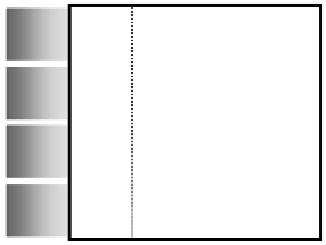Image Processing Reference
In-Depth Information
4. Protocols used in the different testing experiments
Two types of experiments (I and II) have been designed with the purpose of evaluating and
comparing the three trace combination methods presented in the previous section. The
comparison will be performed over the same set of ultrasonic traces for the three cases. The
type-I experiments are based on simulated noisy ultrasonic traces and those of type-II use
experimentally acquired echo-traces. The protocols used in these experiments are an
extension of those we have planned in references (Rodríguez et al 2004a, Rodríguez 2003,
Rodríguez et al 2004b).
4.1 Experiments type-I based on simulated noisy traces
Type-I experiments were carried out with simulated signal registers. They provide adequate
calculation results to confirm the accuracy of the expressions estimated from the theoretical
models of the processing techniques proposed in the equations (3), (5) and (8) to predict the
distinct SNRs (
SNR
2Dtime
,
SNR
2DTFlinear
and
SNR
2DWVT
). So, those expressions could be
validated for an ample range of values in
SNR
ini
with perfectly controlled characteristics in
echo-signals and their associated grain noises. Some results, in a similar context, using these
same rather simple simulated registers, have been compared in a previous work (Rodríguez
et al 2004a) with the obtained results when a more accurate ultrasonic trace generator was
used. A very close agreement between them was observed, which confirms the suitability of
these registers to evaluate those expressions.
The testing case proposed to attain this objective is the location of a punctual reflector into a
rectangular parallelepiped from 2 external surfaces, perpendicular between them, and using
4 transducers by surface. The general scheme of these experiments, with 4 horizontal (H1,
H2, H3, H4) and 4 vertical (V1, V2, V3, V4) transducers is depicted in the Figure 4.
Transducers H3 and V2 receive echoes from the reflector whereas the other transducers (H1,
H2, H4, V1, V3 and V4) only receive grain noise. To assure compatibility of experiments
type-I with experiments type-II, ultrasonic propagation in a piece of 24x24 mm has been
simulated assuming for calculations a propagation velocity 2670 m/s very close to that
corresponding to methacrylate material. The sampling frequency was 128 MHz.
H4
H3
H2
flaw
H1
V1
V2
V3
V4
Fig. 4. Geometry of the inspection case planned to evaluate the different combination
methods: detection of a single-flaw in a 2D arrangement with 16 elemental-cells.

















